Gallery: This Year’s Most Amazing Microscopic Photography
Winners of the Nikon's annual Small World competition represent the best in through-the-microscope photography
Nikon’s annual Small World Competition began in 1974 to showcase the best microscope-aided photography. The competition attracts a fascinating variety of subjects, photographed using a range of microscopy techniques. Many of the images are scientifically important, but all are aesthetically stunning. This year’s 137 winners have been announced, and we’ve got them all here for you.
View photo gallery

1st Place: Arabidopsis thaliana (thale cress) anther (20x)

2nd place: Sonchus asper (spiny sowthistle) flower stem section (150x)

3rd place: Wrinkled photoresist (200x)

4th Place: Anglerfish ovary (4x)

5th Place: Oral surface of a young seastar (40x)

6th Place: Discus fish scales (20x)
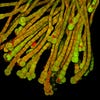
7th Place: Hair-like trichomes on Thunbergia alata (Black-eyed Susan vine) (450x)
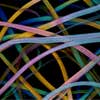
8th Place: Cotton fibers stained with berberine sulphate and color depth shaded (200x)

9th Place: Olivine inclusions in gabbro (magmatic rock) (5x)

10th Place: Algae and diatoms (10x)

11th Place: “Alzheimer” Zebrafish, stained for Tau (red), neurons (green), and pathologic Tau (blue) (10x)

12th Place: Flow pattern in draining soap film (10x)

13th Place: Recrystallized melted mixture of acetanalide, resorcinal and carbon tetrabromide (33x)

14th Place: Lobster egg (3.2x)
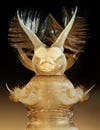
15th Place: Atherix ibis (fly) aquatic larva (25x)

16th Place: Snail eggs (200x)

17th Place: Stopwatch (2.5x)
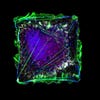
18th Place: Human skin on fibronectin with growth factor (60x)

19th Place: Snowflake (40x)

20th Place: Rusted old coin (40x)

1st Place, Popular Vote: Fluorescent actin bundles growing from the surface of coated beads (63X)

Honorable Mention: Ciliated protozoa (1700x)
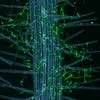
Honorable Mention: Fungal infection of Arabidopsis (flowering plant) root (25x)

Honorable Mention: Rat cerebellum (200x)
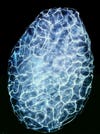
Honorable Mention: Whole finch testicle (4x)

Honorable Mention: Fire agate (10x)

Honorable Mention: Aspergillus mold in a microfluidic device (20x)

Honorable Mention: Aspergillus sp. (250x)

Honorable Mention: Arabidopsis thaliana (thale cress) anther (20x)

Honorable Mention: Radula of Buccinum undatum (sea snail) (100x)

Honorable Mention: Biosensing liquid crystals (20x)

Honorable Mention: Hoya carnosa (wax plant) flower (10x)

Honorable Mention: Pluteus larva of a sea biscuit (echinoderm) (200x)

Honorable Mention: Water droplets ejected from a vibrating glass nozzle (200x)

Honorable Mention: A fruit fly ovariole containing different stages of developing egg chambers (400x)

Honorable Mention: Mosquito larvae (100x)

Eriophorum vaginatum (Tussock cottongrass) corm (10X)

Eriophorum vaginatum (Tussock cottongrass) corm (10X)
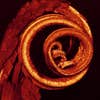
Moth proboscis (10X)

2 pinnae of Aspidium Felix (fern) (20X)

Agate – thin polished section (200X)

Branching filamentous diatom colonies with diatom ‘eyes’ (4X)

Patterned expression of wild-type and transgenic Drosophila melanogaster (fruit fly) embryos (200X)

Soap film (10X)

Dover Sole skin (20X)

Arabidopsis thaliana (thale cress) leaf epidermis and stomata (plant pores) (20X)

Antique microscope slide featuring Sea Cucumber skin and anchors (7.5X)

Pyroxene and plagioclase (minerals) in granulite (metamorphic rock) (5X)

Neurons extending from human embryonic stem cell spheres (20X)
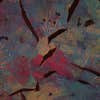
Grey cast iron (1000X)

Re-crystallized urea
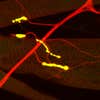
Neuromuscular synapses in a Drosophila larva (200X)

Diatom (480X)

Embryo of guppy fish (40X)

Two Micrasterias sp. (green algae), live specimens (200X)

Two Closterium sp. (algae), live specimens (200X)

Marine diatoms (200X)

Bile duct surrounded by scar tissue in a cirrhotic liver (20X)
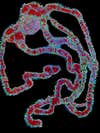
Chromosome from Drosophila melanogaster (fruit fly) salivary glands (1000X)

Benzoic Acid melt crystal (40X)

Benzoic Acid melt crystal (40X)

Echiniscus mediantus (tardigrade, water bear), in various states of movement

Polished grey banded Carnelian (3X)

Section of female Nippostrongylus brasiliensis (nematode) with eggs (200X)

Mouse cranial base (200X)

Human ileum (20X)

A drop of pond water (100X)

Gastric secreting cells of a mouse (40X)
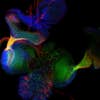
Axonal projections of an ommatidium of Drosophila eye (40X)

Salamander larvae in egg with symbiotic green algae (1X)

Green hydra on surface of spotted salamander egg mass (1X)

Tilia sp. stem (500X)

Silver sand (500X)

Quercus leaf gall formed by a Gall wasp (4X)

Gall formed by Trigonaspis mendesi (4X)
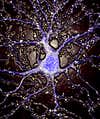
Hippocampal neuron (63X)

Transverse section of brown algae (40X)

Crystal formed from desiccated phosphate-buffered saline (100X)
Degenerating blue phase II crystals (100X)
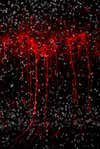
Mouse brain pyramidal cells (20X)

100-form exhibition diatom arrangement (200X)

Elmis sp. (beetle) aquatic larva (60X)

Head of Simulidae (fly) aquatic larva (40X)

Natural textures of the SmF phase of 1,4-di-(n-tridecylthophene-2-yl)-benzene (200X)

Dinosaur bone, Jurassic period (15X)

Raindrop on butterfly wing (20X)

Lime tree leaf vessels (30X)

Neuronally differentiated P19 cells (400X)

Photonic crystals prepared from dried colloidal silica (5X)

Salicornia europea (sprout) (20X)

Urea and mannitol (100X)
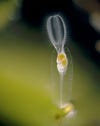
Stephanoceros fimbriata (rotifer) on a moss leaf (80X)

Chalcedony with quartz in quartzite

Chaetopleura Apiculata (Chiton) radula (100X)
GaAs sample oxidized in water vapor (200X)

Recrystallized melt mix of carbon tetra-bromide and resorcinal (33X)

Forelimb bone from a rat

Distribution of actin (green) & microtubule (red) cytoskeletons in fission yeast during mitosis (160X)

Life cycle of the social amoebae Dictyostelium discoideum (100X)

Mouse Purkinje (brain) cells (40X)

Dumbbell sponge spicule from an unidentified sponge (125X)

Lily anther, transverse section, showing pollen sacs (100X)

Lichen (10X)

Notonecta Glauca (Backswimmer aquatic insect) (100X)

Ceratium hirundinella (freshwater dinoflagellate), living specimen (400X)

Filinia terminalis (rotifer) (250X)
Microalgae in silicone matrix (1000X)
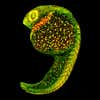
Zebrafish embryo, 22 hours post-fertilization, living specimen (40X)

Drosophila melanogaster immune cells (200X)

Three day old zebrafish larva with fluorescently labeled neurons (20X)

Microprocessor with a pollen grain (50X)
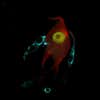
Mouse cultured dorsal root ganglion neuron and satellite cells (1200X)

Xenopus laevis (African clawed frog) tadpole (10X)

Ammonium Dichromate, crystallized (160X)

Beer bubbles (160X)

Oenothera biennis (Evening primrose) pollen grains (650X)

Top of metal tufting hook used in a tufting machine to make carpets (5X)
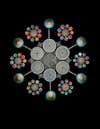
Antique microscope slide featuring arranged diatoms (60X)

Fish scale base, whole mount (125X)

Bundles of quartz fibers with linking bands of Fe-hydroxide (10X)

Dennstaedtia sp. (cup fern) longitudinal rhizome section (10X)

Photonic crystal structure manufactured holographically (100X)
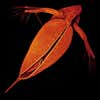
Ventral view of Daphnia pulex (common water flea) (10X)
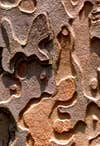
Pine skin (10X)

Alzheimer Zebrafish, stained for Tau (red), neurons (green), synapses and pathologic Tau (blue) (10X)

Rat kidney epithelial cells on a fibronectin surface pattern (630X)

Giant liposomes of pulmonary surfactant (40X)

Arabidopsis thaliana (thale cress) stigma (20X)

Section of circuit board (20X)

Mullerian epithelium from human fallopian tube (400X)

Echinometra lucunter (sea urchin), oral view (20X)

Coral, live polyp showing its mouth, glowing tissue and brown tentacles covering the stony skeleton (6X)

Neuropil in a zebrafish epithalamus (40X)
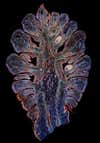
Pinus Ovulate cone mother cell (10X)

Carcinoma cells (40X)

Dried toluidine blue on a Petri dish (35X)
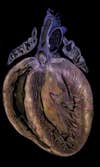
Mammal heart (10X)